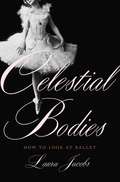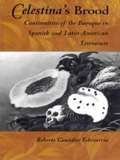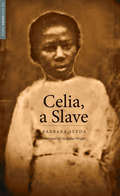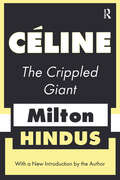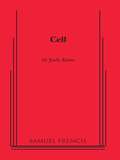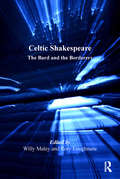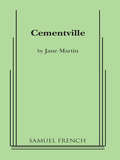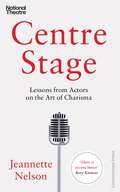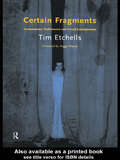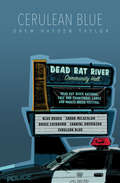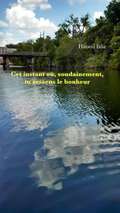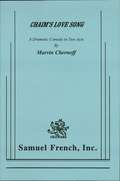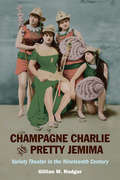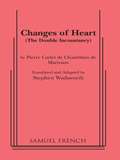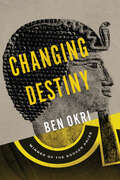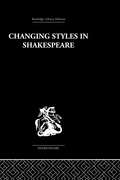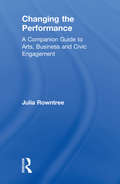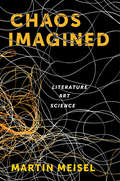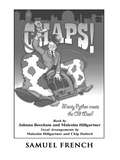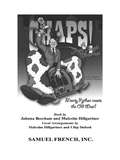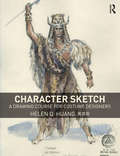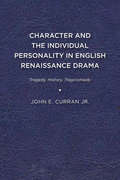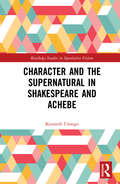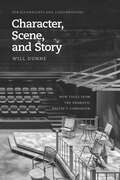- Table View
- List View
Celestial Bodies: How to Look at Ballet
by Laura JacobsA distinguished dance critic offers an enchanting introduction to the art of balletAs much as we may enjoy Swan Lake or The Nutcracker, for many of us ballet is a foreign language. It communicates through movement, not words, and its history lies almost entirely abroad--in Russia, Italy, and France. In Celestial Bodies, dance critic Laura Jacobs makes the foreign familiar, providing a lively, poetic, and uniquely accessible introduction to the world of classical dance. Combining history, interviews with dancers, technical definitions, descriptions of performances, and personal stories, Jacobs offers an intimate and passionate guide to watching ballet and understanding the central elements of choreography.Beautifully written and elegantly illustrated with original drawings, Celestial Bodies is essential reading for all lovers of this magnificent art form.
Celestina’s Brood: Continuities of the Baroque in Spanish and Latin American Literature
by Roberto González EchevarríaPublished in 1499 and centered on the figure of a bawd and witch, Fernando de Rojas' dark and disturbing Celestina was destined to become the most suppressed classic in Spanish literary history. Routinely ignored in Spanish letters, the book nonetheless echoes through contemporary Spanish and Latin American literature. This is the phenomenon that Celestina's Brood explores.Roberto González Echevarría, one of the most eminent and influential critics of Hispanic literature writing today, uses Rojas' text as his starting point to offer an exploration of modernity in the Hispanic literary tradition, and of the Baroque as an expression of the modern. His analysis of Celestina reveals the relentless probing of the limits of language and morality that mark the work as the beginning of literary modernity in Spanish, and the start of a tradition distinguished by a penchant for the excesses of the Baroque. González Echevarría pursues this tradition and its meaning through the works of major figures such as Cervantes, Lope de Vega, Calderón de la Barca, Alejo Carpentier, Carlos Fuentes, Gabriel García Márquez, Nicolás Guillén, and Severo Sarduy, as well as through the works of lesser-known authors.By revealing continuities of the Baroque, Celestina's Brood cuts across conventional distinctions between Spanish and Latin American literary traditions to show their profound and previously unimagined affinity.
Celia, a Slave
by Nicholas Wright Barbara SeydaThe ninth winner of the Yale Drama Series is a searing and powerful drama of slave litigation, injustice, institutional racism, and the rule of law. The winner of the 2015 Yale Drama Series playwriting competition was selected by Nicholas Wright, former Associate Director of London's Royal Court. Barbara Seyda's stunningly theatrical Celia, a Slave is a vivid tableau of interviews with the dead that interweaves oral histories with official archival records. Powerful, poetic, and stylistically bold, this work foregrounds twenty-three diverse characters to recall the events that led to the hanging of nineteen-year-old Celia, an African American slave convicted in a Missouri court of murdering her master, the prosperous landowner Robert Newsom, in 1855. Excavating actual trial transcripts and court records, Seyda bears witness to racial and sexual violence in U. S. history, illuminating the brutal realities of female slave life in the pre-Civil War South while exploring the intersection of rape, morality, economics, and gender politics that continue to resonate today.
Celine the Crippled Giant: Reading The Maternal Imaginary
by Milton HindusLouis Ferdinand Céline (the pseudonym of Louis Destouches) was a famous novelist and ferocious anti-Semitic pamphleteer who rose to fame before Hitler, but perfectly represented the fascist mind-set that swept across Europe between 1932 and 1944. Never a Nazi himself, he was author of Journey to the End of the Night, Death on the Installment Plan, Guignol's Band, Homage to Zola, and a series of "pamphlets." The latter are a potpourri of racist editorials, ballet scenarios, and anti-Semitic confessions so violent that an aesthete like Andre Gide thought them parodies of other anti-Semitic literature. Little wonder the Nazis regarded Céline as a fellow-traveler. He retreated with the Nazis across the Rhine and sought refuge with them, first in Germany and then in Denmark. In 1951, he benefitted from an amnesty as a wounded veteran of both World Wars. Before his death in 1961 he had regained his popularity with the public and was regarded as a classic writer. Now that the body of his work is in translation, Céline's fame in the literary world circles the globe.Céline, perhaps more than any other analysis, helps shed some light on this enigmatic figure. It establishes his literary importance, and, at the same time, examines his anti-Semitism. After a final meeting, Hindus declared that "Celine is a splinter in my mind that I've got either to absorb completely or eject completely." The reader of this fascinating critical memoir of one of the twentieth century's most controversial literary figures is apt to be left with a similar dilemma.
Cell
by Judy KlassCell is a murder mystery - to about the same extent that Sophocles’ Oedipus Rex is a murder mystery. Lieutenant Rodriguez questions Dennis Kadman about his older brother Michael, who has OD’d on heroin in Dennis’ apartment. Dennis wants to know: who gave Michael the drugs? Michael was a cunning, manipulative addict. But he was placed in his brother’s care by the courts – and Dennis tried to keep him alive and drug-free. Through flashbacks, we see the fractious relationship between the brothers, and how they interacted with other “suspects,” including Edith, the Jamaican nurse who believed Michael should be allowed to choose to die; Julie, Dennis’ fiancée who hated what Michael was doing to Dennis and to their relationship; and Byron, Michael’s homeless friend with whom he had lived on the streets. Like Oedipus, while looking for the culprit, Dennis learns far too much about himself.
Celtic Shakespeare: The Bard and the Borderers
by Rory LoughnaneDrawing together some of the leading academics in the field of Shakespeare studies, this volume examines the commonalities and differences in addressing a notionally 'Celtic' Shakespeare. Celtic contexts have been established for many of Shakespeare's plays, and there has been interest too in the ways in which Irish, Scottish and Welsh critics, editors and translators have reimagined Shakespeare, claiming, connecting with and correcting him. This collection fills a major gap in literary criticism by bringing together the best scholarship on the individual nations of Ireland, Scotland and Wales in a way that emphasizes cultural crossovers and crucibles of conflict. The volume is divided into three chronologically ordered sections: Tudor Reflections, Stuart Revisions and Celtic Afterlives. This division of essays directs attention to Shakespeare's transformed treatment of national identity in plays written respectively in the reigns of Elizabeth and James, but also takes account of later regional receptions and the cultural impact of the playwright's dramatic works. The first two sections contain fresh readings of a number of the individual plays, and pay particular attention to the ways in which Shakespeare attends to contemporary understandings of national identity in the light of recent history. Juxtaposing this material with subsequent critical receptions of Shakespeare's works, from Milton to Shaw, this volume addresses a significant critical lacuna in Shakespearean criticism. Rather than reading these plays from a solitary national perspective, the essays in this volume cohere in a wide-ranging treatment of Shakespeare's direct and oblique references to the archipelago, and the problematic issue of national identity.
Cementville
by Jane MartinComedy / 5m, 9f / Interior / The comic sensation of the 1991 Humana Festival at the Actors Theatre of Louisville, this play by the author of Talking With and numerous hits is a brilliant portrayal of America's fascination with fantasy entertainment. In a locker room in a seedy arena in Tennessee, the scurvy bunch of professional lady wrestlers includes Tiger who has a drinking problem and a small dog; Dani who displays a chip on her shoulder against the promoter who owes the girls several weeks' pay; Lessa, an Olympic shot putter with delusions of being a pro athlete and Netty, an overweight older woman who appears in the ring as "Pajama Mama." The eager beaver go fer Nola and the Knockout Sisters, refugees from the Big Time banned for drug and other abuses, complete the roster for tonight's main attraction. Sparks fly when the other women find out about them.
Centre Stage: Lessons from Actors on the Art of Charisma
by Jeannette NelsonHow the world’s best actors communicate with gravitas – and how you can, too.‘The theatre stars’ voice guru’ Daily MailActing is all about charisma. Whether you’re an A-list star or an extra, when you’re on stage you need to perform in a way that makes your audience listen.That stage presence is something we can all learn from. Every time you speak up in a meeting, recount an anecdote, or tell a joke, it’s essential to communicate with gravitas.Jeannette Nelson knows a thing or two about gravitas. As Head of Voice at the National Theatre, she has spent three decades working with the world’s leading actors – from Al Pacino to Benedict Cumberbatch to Juliette Binoche – teaching them to speak clearly and move confidently.Now, Nelson pulls back the curtain on the tricks that professional performers use to own the room. Starting with clear speech and good posture, before moving on to the art of rhetoric and overcoming stage fright, she outlines a holistic three-stage method to communicating with authority, authenticity and eloquence. Throughout, she peppers the book with stories of how world-renowned actors learnt to make themselves heard – and how you can, too.The result is a fascinating and eminently practical guide to the art of performance. If all the world’s a stage, then this book will turn you into its lead actor.
Certain Fragments: Texts and Writings on Performance
by Tim EtchellsWhat is the relationship between performance and play? Between performance and technology? Between performance and death? Certain Fragments is an extraordinary exploration of what lies at the heart of contemporary theatre. Written by the artistic director of Forced Entertainment, acknowledged to be Britains most brilliant experimental theatre company (Guardian), Certain Fragments investigates the processes of devising performance, the role of writing in an interdisciplinary theatre, and the influence of the city on contemporary art practice. Tim Etchells unique and provocative voice shifts from intimate anecdote to critical analysis and back again. And as in his theatre-making so in his book: with Certain Fragments Etchells disrupts traditional notions of creative, academic, and intellectual work. The book is an exciting and radical fusion of story-telling and criticism. It also makes available, for the first time, four seminal Forced Entertainment texts by Etchells.
Cerulean Blue
by Drew Hayden TaylorCerulean Blue is a comedic play about a struggling blues band invited to participate in a benefit concert for a First Nation community in conflict with governmental authorities. Upon arriving, the band discovers the entire lineup of musical acts has cancelled and they're left trapped behind barricades. Complicating the matter, there is conflict within the band and the sudden appearance of an old girlfriend makes the event even more perilous. This play is an homage to fast-moving farces while also addressing Aboriginal issues. Cerulean Blue deals with relationships, perceptions, politics, and what to do when you discover you've been dating your first cousin. Add a few spoonfuls of original blues music, and you've got a fun-filled evening. The play was written for a large ensemble cast, which makes it ideal for musical theatre departments in high schools and colleges - every student can play a part. An original musical score by Andrew Clemens will be available for download from Talonbooks.com. Cast of ten women and ten men.
Cet instant où, soudainement, tu ressens le bonheur
by Hitomi IidaUne longue lettre d'amour à mon âme sœur qui me regarde avec nostalgie par-delà le temps et l’espace
Chaim's Love Song
by Marvin ChernoffDramatic comedy / 3m, 4f / Unit set / Chaim Shotsky, a retired mailman in Brooklyn, is an American Tevye who tells his life story to Kelly Burke from Iowa. His exotic tale is rich with vitality. His friends include a philosophical baker, a Holocaust survivor with many secrets, his son and daughter, a matchmaker to end all matchmakers, movie star pigeons and a host of Israelis. Chaim's story, a love song for life, is one of innocence, tragedy, struggle, humor, humanity and ultimately triumph.
Champagne Charlie and Pretty Jemima: Variety Theater in the Nineteenth Century (Music in American Life #441)
by Gillian M RodgerIn this rich, imaginative survey of variety musical theater, Gillian M. Rodger masterfully chronicles the social history and class dynamics of the robust, nineteenth-century American theatrical phenomenon that gave way to twentieth-century entertainment forms such as vaudeville and comedy on radio and television. Fresh, bawdy, and unabashedly aimed at the working class, variety honed in on its audience's fascinations, emerging in the 1840s as a vehicle to accentuate class divisions and stoke curiosity about gender and sexuality. Cross-dressing acts were a regular feature of these entertainments, and Rodger profiles key male impersonators Annie Hindle and Ella Wesner while examining how both gender and sexuality gave shape to variety. By the last two decades of the nineteenth century, variety theater developed into a platform for ideas about race and whiteness. As some in the working class moved up into the middling classes, they took their affinity for variety with them, transforming and broadening middle-class values. Champagne Charlie and Pretty Jemima places the saloon keepers, managers, male impersonators, minstrels, acrobats, singers, and dancers of the variety era within economic and social contexts by examining the business models of variety shows and their primarily white, working-class urban audiences. Rodger traces the transformation of variety from sexualized entertainment to more family-friendly fare, a domestication that mirrored efforts to regulate the industry, as well as the adoption of aspects of middle-class culture and values by the shows' performers, managers, and consumers.
Changes Of Heart
by MariveauxMarivaux's fabulous Harlequin pursues his country love Silvia to the palace, where the lovelorn Prince holds her against her will. Flaminia, an intriguer at court, attempts to reroute the affections of both Silvia and Harlequin, whose take no prisoners belligerence is softened and transformed. None expect such huge and costly changes of heart and, at the end of a hilarious day full of wonderment, they and others at court are wounded and ennobled by love.
Changing Destiny
by Ben OkriA bold new adaptation of the 4,000-year-old Egyptian poem about Warrior King Sinuhe that captures the essence of civilization and the complexities of immigration, from the Booker Prize–winning author.Forced to flee Egypt, Sinuhe is captured as a prisoner of war by the foreign Kingdom of Retenu. Stripped of status and tormented by memories, Sinuhe will need great force of will to survive as a stranger in an unknown land. But can he transcend the mysterious powers of Egypt and the tribulations of exile?With two actors incarnating a multitude of characters, Ben Okri&’s play recreates one of the world&’s first known stories, a timeless tale about the strength of the human spirit.
Changing Styles in Shakespeare
by Ralph BerryFirst published in 1981. Each of Shakespeare's plays is in a continuous state of development in performance. This book examines major changes whilst focusing on six plays in detail: Coriolanus, Measure for Measure, Troilus and Cressida, Henry V, Hamlet and Twelfth Night. Changing Styles in Shakespeare looks at representative and key productions to trace the evolution of each play on today's stage, illustrating how production changes relate to a changed perception of the play, and thus to shifts in social attitudes. It singles out the salient features of many productions, paying special attention to reviews and prompt books.
Changing the Performance: A Companion Guide to Arts, Business and Civic Engagement
by Julia RowntreeA result of many years of research and practice, Changing the Performance is a book about the arts and about business, and the interplay between the two. Julia Rowntree gives a fascinating account of her experiences forging the business sponsorship campaign at the London International Festival of Theatre (LIFT). Raising intriguing questions, this book proposes that fundraising for the arts is much more than simply a function for generating income. It fulfils an ancient social role of connection across levels of power, expertise, culture, gender and generation. Rowntree describes why these dynamics are vital to society's ability to adapt. Changing the Performance is an inspiring manual for arts practitioners concerned with the relationship between business, the arts and wider society, and particularly those engaged in fundraising.
Chaos Imagined: Literature, Art, Science
by Martin MeiselThe stories we tell in our attempt to make sense of the world—our myths and religion, literature and philosophy, science and art—are the comforting vehicles we use to transmit ideas of order. But beneath the quest for order lies the uneasy dread of fundamental disorder. True chaos is hard to imagine and even harder to represent. In this book, Martin Meisel considers the long effort to conjure, depict, and rationalize extreme disorder, with all the passion, excitement, and compromises the act provokes.Meisel builds a rough history from major social, psychological, and cosmological turning points in the imagining of chaos. He uses examples from literature, philosophy, painting, graphic art, science, linguistics, music, and film, particularly exploring the remarkable shift in the eighteenth and nineteenth centuries from conceiving of chaos as disruptive to celebrating its liberating and energizing potential. Discussions of Sophocles, Plato, Lucretius, Calderon, Milton, Haydn, Blake, Faraday, Chekhov, Faulkner, Wells, and Beckett, among others, are matched with incisive readings of art by Brueghel, Rubens, Goya, Turner, Dix, Dada, and the futurists. Meisel addresses the revolution in mapping energy and entropy and the manifold effect of thermodynamics. He then uses this chaotic frame to elaborate on purpose, mortality, meaning, and mind.
Chaps!
by Jahnna Beecham5m, 1f -- Musical Comedy \ Unit Set \ Whoa, Brittania! Panic at the BBC! The year is 1944, America's favorite singing cowboy Tex Riley and his troupe are late for a special broadcast at the BBC in London. Out of desperation, Mabel, their tour manager, and Miles, the frantic young producer, grab whomever they can -- a snobby announcer, an amiable sound man, a passing soap opera actor -- slap them into costume, hand them scripts (after all, it's radio!) and shove them in front of the studio audience. The resulting performance is one England will never forget. Also available in a special holiday version, Chaps! A Jingle Jangle Christmas. \ "...Combine Monty Python and Tex Ritter, and you get a bloody funny singing buckaroo!" -- Herald News, Klamath Falls, OR
Chaps! A Jingle Jangle Christmas
by Jahnna Beecham5m, 2f \ Holiday Musical Comedy \ All Groups -- Unit Set \ Whoa, Brittania! Panic at the BBC! It's Christmas Eve, 1944. America's favorite singing cowboy Tex Riley and his troupe are late for a special holiday broadcast at the BBC. Out of desperation, Mabel, their tour manager, and Miles, the frantic young producer, grab whomever they can -- a snobby announcer, an amiable soundman, a passing soap opera actor -- slap them into costume, hand them scripts (after all, it's radio!) and shove them in front of the studio audience. The resulting performance is one England will never forget full of Christmas songs and quirky cowboy tunes. This is the holiday version of Chaps! \ "...Combine Monty Python and Tex Ritter, and you get a bloody funny singing buckaroo!" -- Herald News , Klamath Falls, OR
Character Costume Figure Drawing: Step-by-Step Drawing Methods for Theatre Costume Designers
by Tan HuaixiangCharacter Costume Figure Drawing is an essential guide that will improve your drawing skills and costume renderings. Step-by-step visuals illustrate the how-tos of drawing body parts, costumes, accessories, faces, children, and different character archetypes, such as maternal, elderly, sassy, sexy, and evil. By focusing on the foundations of drawing bodies, including body proportion, bone structure, body masses, facial expressions, and appendages, this guide shows you how to develop sketches from stick figures to full-blown characters. The third edition features a new chapter, Digital Mixed Media Costume Rendering. This chapter introduces the basic usages of Photoshop tools to enhance and improve costume designs, in order to provide easy delivery design ideas to the director and design team, provide easy changes and alterations during the design process, virtually apply actual fabric swatches over costume sketches, and help visualize lighting effects.
Character Sketch: A Drawing Course for Costume Designers
by Helen Q HuangCharacter Sketch outlines a theory of costume rendering that explores how a designer conceptualizes and creates a character on the page. Beginning with how to develop a sense of character through active, gestural poses, this book explores and explains the process of drawing and painting from rough sketch to finished rendering. Helen Q. Huang 黄其智, an award-winning costume designer for more than 25 years, breaks down her process, from understanding body proportions and active poses to applying research and color concepts to renderings. Her step-by-step watercolor painting techniques cover mixing skin tones, blending colors, and applying paint in different methods for a variety of fabric textures and patterns. Showcasing how to capture a character on the page, Character Sketch is a must-read for any costume designer looking to communicate their artistic vision.
Character and the Individual Personality in English Renaissance Drama: Tragedy, History, Tragicomedy (G - Reference, Information And Interdisciplinary Subjects Ser.)
by John E. CurranCharacter and the Individual Personality in English Renaissance Drama: Tragedy, History, Tragicomedy studies instantiations of the individualistic character in drama, Shakespearean and non-Shakespearean, and some of the Renaissance ideas allowing for and informing them. Setting aside such fraught questions as the history of Renaissance subjectivity and individualism on the one hand and Shakespearean exceptionalism on the other, we can find that in some plays, by a range of different authors and collaborators, a conception has been evidenced of who a particular person is, and has been used to drive the action. This evidence can take into account a number of internal and external factors that might differentiate a person, and can do so drawing on the intellectual context in a number of ways. Ideas with potential to emphasize the special over the general in envisioning the person might come from training in dialectic (thesis vs hypothesis) or in rhetoric (ethopoeia), from psychological frameworks (casuistry, humor theory, and their interpenetration), or from historiography (exemplarity). But though they depicted what we would call personality only intermittently, and with assumptions different from our own about personhood, dramatists sometimes made a priority of representing the workings of a specific mind: the patterns of thought and feeling that set a person off as that person and define that person singularly rather than categorically. Some individualistic characters can be shown to emerge where we do not expect, such as with Fletcherian personae like Amintor, Arbaces, and Montaigne of The Honest Man’s Fortune; some are drawn by playwrights often uninterested in character, such as Chapman’s Bussy D’Ambois, Jonson’s Cicero, and Ford’s Perkin Warbeck; and some appear in being constructed differently from others by the same author, as when Webster’s Bosola is set in contrast to Flamineo, and Marlowe’s Faustus is set against Barabas. But Shakespearean characters are also examined for the particular manner in which each troubles the categorical and exhibits a personality: Othello, Good Duke Humphrey, and Marc Antony. Published by University of Delaware Press. Distributed worldwide by Rutgers University Press.
Character and the Supernatural in Shakespeare and Achebe (Routledge Studies in Speculative Fiction)
by Kenneth UsongoThrough mainly a New Historicist critical approach, this book explores how Shakespeare and Achebe employ supernatural devices such as prophecies, dreams, gods/goddesses, beliefs, and divinations to create complex characters. Even though these features indicate the preponderance of the belief in the supernatural by some people of the Elizabethan, Jacobean, and traditional Igbo societies, Shakespeare and Achebe primarily use the supernatural to represent the states of mind of their protagonists. Both writers appropriate supernatural features to mirror tragic flaws such as ambition, arrogance, impulsiveness, and fear that contribute to the downfall of Macbeth, Lear, Okonkwo, and Ezeulu. We relate to some of these characters because they project our inner minds, principal drives that may be hidden within us. Therefore, Shakespeare and Achebe’s preoccupation with the supernatural adds subtlety to their characterization and enhances their readability by situating their art beyond time, place, or particularity.
Character, Scene, and Story: New Tools from the Dramatic Writer's Companion (Chicago Guides to Writing, Editing, and Publishing)
by Will DunneWill Dunne first brought the workshop experience down to the desk level with The Dramatic Writer’s Companion, offering practical exercises to help playwrights and screenwriters work through the problems that arise in developing their scripts. Now writers looking to further enhance their storytelling process can turn to Character, Scene, and Story. Featuring forty-two new workshop-tested exercises, this sequel to The Dramatic Writer’s Companion allows writers to dig deeper into their scripts by fleshing out images, exploring characters from an emotional perspective, tapping the power of color and sense memory to trigger ideas, and trying other visceral techniques. The guide also includes a troubleshooting section to help tackle problem scenes. Writers with scripts already in progress will find they can think deeper about their characters and stories. And those who are just beginning to write will find the guidance they need to discover their best starting point. The guide is filled with hundreds of examples, many of which have been developed as both plays and films. Character, Scene, and Story is fully aligned with the new edition of The Dramatic Writer’s Companion, with cross-references between related exercises so that writers have the option to explore a given topic in more depth. While both guides can stand alone, together they give writers more than one hundred tools to develop more vivid characters and craft stronger scripts.
